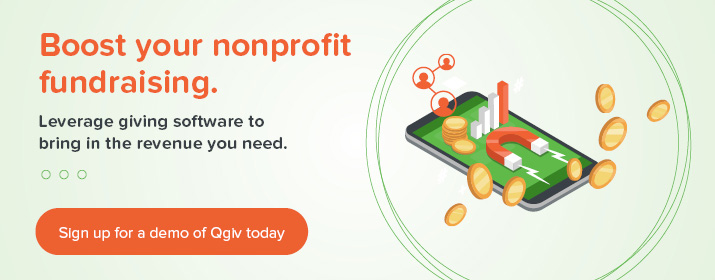As your nonprofit organization continues to grow, it’s time to consider investing in an effective fundraising platform that truly accommodates your nonprofit’s size, financial needs, and developing fundraising strategies. Think carefully about the cost of your fundraising activities and the long-term impact your nonprofit potentially has on your community. Creating a sustainable, scalable fundraising campaign that will help you grow your future impact is just as important as reaching your fundraising goal.
Why is fundraising important for nonprofits?
Fundraising is important for nonprofits because it supports each organization’s work by providing financial revenue and setting up opportunities for future engagement with donors. With an effective and sustainable nonprofit fundraising campaign, charities have the potential to engage broad audiences and increase their impact as their funding grows. Sustainable fundraising practices can help you grow, ensure long-term support, and even aid larger projects like funding research. Learn about how to run an effective and sustainable campaign by reading from the top or jumping to the sections that most interest you:
- Develop a Strategy
- Understand the Giver’s Journey
- Focus on Acquiring and Retaining Donors
- Leverage Nonprofit Fundraising Best Practices
Are you ready to maximize your fundraising efforts and see real results? Let’s begin.

Develop a Strategy
Every fundraising initiative has a cost, and there is a delicate balance between fundraising revenue and expenses. All fundraisers know that their main goal is to raise money, but not all of them think about sustainability or scalability. Focus on tried-and-true opportunities for growth in order to be prepared for the long term. When developing a fundraising strategy, your best bet is to concentrate on two areas: your most productive donor groups and high-impact donor recruitment and retention. Create engaging opportunities for new donors, but make sure those opportunities will be profitable in the long run. You don’t want the money you spend on your campaign to be more than the money you raise! You’ll also need to add software and online solutions to your fundraising strategy. The tools you choose will depend on your nonprofit’s unique needs! Creating the perfect fundraising strategy takes a lot of time and effort, so your best bet to grow and raise more each year is to first lay out a solid fundraising foundation. Your fundraising strategy should include plans for donor acquisition and retention with an emphasis on recruiting high-impact donors. Once you have that part in place, it’s time to find fundraising tools that will help you meet those goals. This means identifying effective and capable tools to help you make strategic moves based on accurate, updated data.
Use a CRM to help with donor research
Data-driven fundraising strategies are always the smartest move, so make sure you have the necessary constituent relationship management software (CRM) integrations and reporting tools. A good CRM will help you track your donors’ giving history, document their engagement with your organization, and help you identify opportunities to build strong donor relationships that will last for years. They’ll also help you build profiles on your donors that include their contact information and communicatino preferences. These days, investing in fundraising tools with CRM integrations is more of a necessity than general fundraising advice. Having access to donor data is important for learning donor habits and increasing donor retention. By using a CRM’s fundraising reporting tools, you can compile effective reports that help you understand and document your research into your donor base. With this research, you can start developing and improving your fundraising plan. So, if you know you want to attract high-impact donors and retain them, turn to the data in your CRM. What groups of people tend to be your most invested donors? Where did you find them? How do you communicate with them? Using your CRM to understand those patterns will help you replicate past successes.
Lay out a fundraising plan
Thanks to your CRM, you know who you want your new donors to be. Now it’s time to plan out how you’ll find them! Nonprofit fundraisers should be based on an established plan. It’s important your fundraising team sets up a:
- Realistic fundraising goal. Consider how much you should raise to effectively help your mission while keeping your budget in mind.
- Timeline for the campaign. Time limitations provide a sense of urgency, motivating donors, and encouraging you to establish smaller, manageable goals leading up to your larger one.
- Budget for expenses. Don’t risk accidentally spending more on your fundraising activities than you raise.
- Gift range chart. This notes the number of donations needed to reach your goal, as well as the number of donations at varying levels you need to solicit. For example: if you know that your average donor gives you ~$70, that some of your donors give $100+, and that a large portion of your donors give at the $25 level, you can make some solid predictions about how your donors will interact with your campaign. You should note how many prospects you may have to reach out to at each giving level. Base this on your documented research, and follow it carefully!
Measure all fundraising metrics
No matter how extensive your software features are, the most important thing is that all of these metrics are stored in your centralized CRM system. Use the data in your CRM to measure all metrics, including donation amounts, donation frequency, donor details, and more!
Then, evaluate what donor acquisition and engagement strategies worked and what didn’t.
Use your CRM or your fundraising platform’s dashboard to track the number of:
- New, lapsed, or at-risk donors.
- Donor retention and churn rates.
- Donor lifetime value.
If your retention rates start to falter, you know your overall strategy needs to be tweaked.
Note what performed well and what didn’t
After you wrap up each campaign, take time to review what tactics worked and where you can improve. Use your CRM and fundraising software to compile reports that include data like how users found your donation form, their giving method and amount, and if they engaged with you online or in person. This way, you can note which engagement methods were most successful and focus your energies accordingly in the future! You may also be able to identify areas for improvement; if you notice your in-person engagement strategy fell short of its goal, you may be able to tweak that strategy in the future. The common thread to follow throughout these strategic steps is that you should base your strategy and fundraising efforts on concrete data and research, then use that data to constantly tweak and improve your methods. Your nonprofit’s fundraising team should be consistently using your data to improve your techniques! With the right fundraising software solution, you can learn from past campaigns to tweak and develop your strategies.

Understand the Giver’s Journey
To truly create a sustainable nonprofit fundraising campaign, you need to fully understand your giver’s journey. Though each of your donors and supporters is unique and different, they all follow a similar journey as they get to know your nonprofit’s mission and make each gift. Understanding each stage of that journey will help you identify sticking points and obstacles your donors may encounter! Removing those obstacles will boost your conversion rates, which means you’ll attract more donors and raise more money.
The Giver’s Journey
As you work toward attracting new donors and retaining existing ones, it’s important to increase awareness about your cause and give your supporters the tools and resources they need to confidently donate to your nonprofit. Here are the main steps of the giver’s journey:
- A potential donor becomes aware of your organization, mission, and work. Make a lasting first impression! You can do this by hosting events to launch your campaigns or using relevant media to introduce your cause across various social platforms.
- If the potential donor is interested in your organization, they begin to research who you are. Make sure you provide an easy way to access the information they’re looking for. For example, our Generational Giving Report found that donors from the Baby Boomer generation look for financial reports and tax returns as they research nonprofits. With that in mind, you’ll want to optimize your main organization’s website to be easily navigable and to make your 990 and impact reports easy to find. For other donors, you’ll want to present relevant information so they understand your nonprofit’s main mission and the impact they’ll make by supporting your work. After all, supporters are nearly 70% more likely to give a second donation if they used a branded page with an impact statement the first time they gave.
- Give your donor a reason to give. Your donor’s research might spark an interest in researching your cause and other organizations that do similar work. It’s great that you educated someone about your cause, but you don’t want to drive them to a different organization. Keep new supporters interested in your work by highlighting the real impact they can have by giving to your nonprofit. Share stories and testimonials from the people you help! You can also make sure your marketing material includes case studies and real stories from the people you help.
- The potential donor turns into a donor after evaluating their options and donating to the organization. If someone decides to donate to your cause, you need to make this process as quick and convenient as possible. Make sure you have an easy-to-use online donation form, multiple ways to give (like text fundraising!), and other elements like suggested giving amounts, recurring gift capability, and a searchable matching gift database!
As you lead potential donors to make that gift, make sure the process is positive and streamlined so that they’ll be more likely to donate again later.
After the Donation
The post-donation phase is when donors either feel good about their gift or totally forget about it. That’s why it’s important to show donor appreciation and be clear about the donor’s positive impact. Consider ways to guarantee your fundraising efforts have a sustainable, long-term impact! The two easiest ways to meet that goal are ensuring that the donor recommends your organization to their family and friends and by encouraging the donor to turn into a recurring donor. Try using these post-donation engagement methods:
- Personalized emails. By integrating your fundraising tools and your CRM system, your communications team can use accurate donor data to individualize email content. Make sure you always include your donor’s name and donation details, but take time to include some feel-good elements, too. Something as simple as a high-quality image and a sincere thank-you message can make a huge impression on a donor. Send out messages as soon as the gift is made! Then, follow up with your donor and share the outcome of your campaign once it’s finished.
- Social media outreach. Use your social media platforms to share updates about your donors’ impact, invite supporters to events, and even to ask for feedback on past events and campaigns! Ensure you allow comments and actively participate in the conversation. Social media was the #1 source of inspiration for donors in 2020, so it pays to keep up with it!
- Phone calls. If you can, call donors and personally thank them for their gift as well as update them on your campaign. However, there is a fine line between developing a personal relationship and annoying donors with constant asks! Limit your phone call to thanking your donor and telling them what their gift will achieve. Identify the best ways to reach out based on your donor data and reports.
- Direct mail. A physical letter is also a great way to show appreciation for a gift. Similar to your email content, make sure you personalize the content and share the positive impact your donor made with their gift.
An effective nonprofit fundraising campaign will focus on raising money and creating sustainability for your nonprofit. Make sure you and your staff optimize each stage of the giver’s journey to ensure your nonor understands their impact on your mission, give your nonprofit opportunities to build relationships with donors, and lay the groundwork for future success. Once your donor makes a gift, it’s time to focus on retaining them! The first gift a donor makes is good. The second gift a donor makes is great! Once you secure that golden second donation, your donor is more likely to give again and again.
Focus on Acquiring and Retaining Donors
Your nonprofit’s sustainability and scalability depends on your engagements and relationships with your donors. When you build relationships with your donors, you’re not just raising fundraising revenue! You’re building an engaged donor base that will support you for years to come. It’s a critical way to grow your nonprofit and will pave the way to creating a long lasting and durable impact. Spending time targeting and prioritizing building relationships with high-impact loyal donors can increase support at a minimal cost to the organization. How can you best engage potential donors as they begin the giver’s journey and retain them after the gift?
Donor communications
Did you know that one of the biggest reasons people don’t make a charitable gift is because they aren’t asked? Don’t be afraid to ask your donors for donations! Use the communication streams that your supporters use the most, including:
- Text messages
- Social media platforms
Donors want to know that their gift will make an actual impact, so use your fundraising appeal to let them know exactly what their gift will achieve. Share a problem with them, then tell them how to solve that problem. Prospective donors won’t know your needs if you don’t communicate them.
Share fundraising successes
Let donors know when they’ve made a difference! As you already know, developing donor relationships is important to your fundraising sustainability efforts. Sharing success stories from your past campaigns creates good feelings and shows the tangible outcomes of your donors’ gifts. Make the biggest impact by telling donors that their gift made an impact, then communicate what that impact was.
Be transparent
When donors give to your cause, they’re trusting that your nonprofit will use the money wisely. Be transparent with your actions, and let donors in on:
- The day-to-day activities of your staff and volunteers through newsletters and your social media accounts.
- All fundraising initiatives, whether you successfully reach your goals or not.
- Past successes and future plans.
Create events
Events are a great way to build relationships with donors. It gives your donors a chance to feel like they’re a part of a larger community and can also create ample networking and sharing opportunities. Encourage donors to bring their friends and family as well! While at your event, potential donors should be able to get a better sense of what your organization does and how you approach your mission. Fundraising events are a great way to educate your donors, inspire them to make a difference, and encourage them to give. Alternatively, you could put together a donor appreciation event that focuses more on thanking and recognizing donors and less on fundraising.
Segment donors
You can use your fundraising software and CRM to segment your donors and supporters based on specific metrics for more targeted communication. Donors want information that’s relevant to their history with your nonprofit! Segment your audience and individualize your appeals, receipts, thank-you notes, and newsletters with:
- Giving preferences
- Communication preferences
- Business affiliations
- Event attendance
- Donor type (recurring, one-time, major gifts, etc.)
Optimize your fundraising website
More likely than not, donors will first turn to your organization’s website for information about your work and how you make an impact in your community. Make it easy for prospective donors to give by including your website link in your social media platform bio, in articles you write, and in your fundraising emails. On your home page, be clear about your mission and how donors’ support will make a difference, then include an easy-to-locate “Donate” button. In addition to making your website more accessible from outside channels, ensure your website and all of its pages are easy to navigate. For example, make sure your “Donate” button is on all your pages and links directly to your online donation page. Draw attention to your “Donate” button with bright colors and CTAs.
Be personal
According to one donor loyalty study, over half of your donors give because they’re passionate about your cause rather than loyal to your organization. Think of your nonprofit’s work and impact as a story with your donors as the hero. Tell your story through marketing outlets like your website, social media platforms, and email newsletters. Use media like photos and videos to describe your mission and encourage donors to become emotionally invested in your work. Show them the problem you’re solving, the impact they can make by donating, and how to get involved!
Invite readers to get involved
Always invite prospective donors to join you in changing the world. Whether you’re seeking financial donations, in-kind contributions, or volunteers (volunteers are donors, too!), use your social connections to turn prospective donors into actual donors.
Donor retention
While acquiring high-impact donors with long term support is the key to sustaining your nonprofit’s work, it’s more cost-effective to retain existing donors than it is to constantly acquire new ones. According to one study, over 70% of new donors recruited to a nonprofit never make a second gift. If that’s the case for your organization, you have to continuously spend additional money on donor acquisition. That gets expensive! Your nonprofit fundraising campaigns should always attract new supporters. But without consistent donor retention efforts, nonprofits can’t grow and be sustainable. Increase donor retention with these tips:
- Focus on the “after donation” portion of a giver’s journey.
- Keep up communications, updates, and donor engagement opportunities to increase the chance that they give again.
- Encourage supporters to become recurring donors and automate the process for them.
- Offer donors access to exclusive updates, events, and potentially even merch! You can use a membership site to create an exclusive experience for donors that keeps them in-the-know (and in support of) your organization.
Leverage Nonprofit Fundraising Best Practices
You already know that your nonprofit software should help establish your web presence and streamline internal processes like your online donation form. However, there are additional ways to leverage your tools and features in order to maximize your fundraising potential and ensure your nonprofit’s sustainability.
Build an intuitive, uncluttered website
A common mistake is putting too much information on your site. Too much text or too many images will make your web pages look cluttered and confusing, and that can cause potential donors to close that window and not visit again. Additionally, your site’s navigation menu should be prominently and obviously positioned so visitors can quickly navigate to different pages. A good way to gauge your navigation menu’s usability is to ask someone to look at it for you. If they can’t find what they want in 3 seconds, it’s too complicated! Your website needs to reflect your nonprofit in an intuitive way, and it should be easily updated to support future campaigns and fundraising efforts.
Optimize your online donation form
After a visitor lands on your website and decides to give to your nonprofit, your online donation form should never be the reason not to finish their gift! Your online fundraising platform should make it easy to customize and optimize your online donation form. Be sure to:
- Save donors time. Customize your form to ask only for pertinent details. Prevent donors from having to enter the same data more than once with good form design! For example, if a donor’s billing address and mailing address are the same, you can offer a checkbox so they don’t have to enter their address twice.
- Include suggested donation amounts (with descriptions!). This gives donors a concrete suggestion for a donation size and will reassure them that their gift will make an impact. Pairing each donation amount with specific descriptions can also encourage donors to make a slightly larger gift than they originally intended.
- Reflect your nonprofit’s unique brand. Use your fundraising tools to brand your online donation form . You can also use your branding to fully customize donation receipts, thank you emails, and donor summaries, which will facilitate a cohesive donation process that connects a donor to your nonprofit’s work at every step.
Your online donation form should do more than just take someone’s financial information—it should reinforce their positive feelings toward your organization. Here’s a checklist that will help you make your donation form user-friendly!
Optimize your website for mobile
Along with building an intuitive and uncluttered website, make sure your web pages can be easily accessed and used on any device. If your website isn’t optimized for mobile devices, it can irritate donors and reduce your ranking in search engines. In fact, over half of donors will visit your nonprofit’s website from their mobile form, and mobile-responsive donation pages yield 34% more donations. Making sure your website is mobile-ready is a simple tip that can make a big impact! Make sure your website is mobile-accessible and read our guide on how to design a great mobile donation form.
Leverage text fundraising
Text fundraising can be especially effective during urgent fundraising efforts. Text giving been growing rapidly for years, with donations made by text growing by a whopping 26% in 2019. It’s a great method for people who want to give quickly, letting donors contribute whenever it is convenient for them. Add text fundraising to your next nonprofit campaign and encourage sustainability for your future fundraising efforts.
Final Thoughts
Launching a nonprofit fundraising campaign can feel like a daunting task. It requires your team to do a ton of planning and preparation! While you’re perfecting your fundraising strategy, make sure you use reliable and capable fundraising software to build your foundational fundraising assets. Don’t just consider the best ways to raise revenue in the short term. Think in the long term and how your nonprofit can grow your donor base to create the most meaningful impact. With the right tools, you can create a sustainable campaign strategy that will pave the way for future growth.
If you’re looking for more information about nonprofit fundraising or donation software, check out these additional resources:
- Capital Campaigns | The New Guide for Growing Nonprofits. Are you considering launching a capital campaign? Read this guide first to ensure you’re fully prepared.
- Online Fundraising Platforms: 12 Questions Before You Buy. If you’re on the search for an effective fundraising solution, there are some questions you have to ask beforehand.
- Hiring a Capital Campaign Consultant: 5 Steps to Follow. If you need additional help and guidance for your upcoming campaign, consider hiring a consultant to assist with the process.










